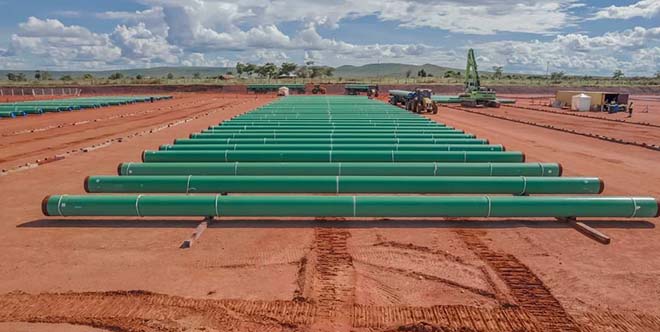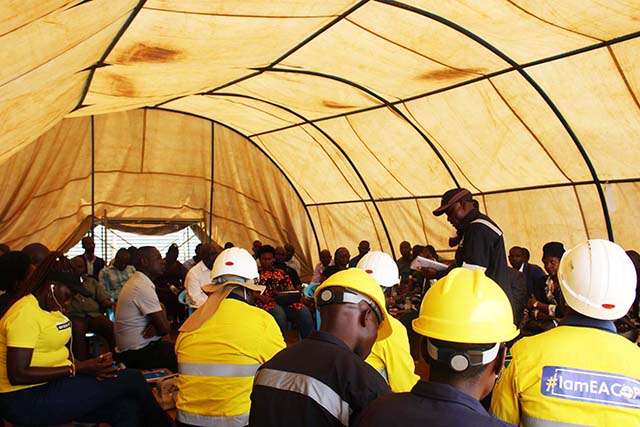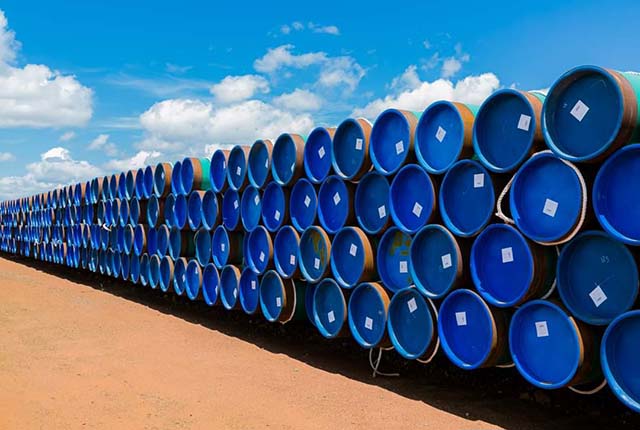
1445km. COURTESY PHOTO/EACOP.
Project has so far received pipes for 700km of the pipeline route as 80 individuals face lawsuits over compensation refusal
COVER STORY | RONALD MUSOKE | The Ugandan government, together with its oil development partners, are pressing forward with the multi-billion-dollar project despite ongoing opposition.
The East African country discovered billions of barrels of crude oil in 2006 but has since struggled to commercialize the resource owing to several factors including disagreement with international oil companies over development strategy but also opposition from both local and international climate change activists and conservationists.
In July, last year, the Human Rights Watch published a report that noted how Uganda’s planned projects, particularly the EACOP, “has devastated thousands of people’s livelihoods in Uganda and will contribute to the global climate crisis.”
“EACOP has been a disaster for the tens of thousands who have lost the land that provided food for their families and an income to send their children to school and who received too little compensation from TotalEnergies,” noted the report titled, “Our Trust is Broken: Loss of Land and Livelihoods for Oil Development in Uganda.”
But the government led by President Yoweri Museveni, has all the while pushed back ‘opposition talk,’ insisting the country will produce and sell its crude oil to spur the country’s economic growth and development. And if all goes according to plan, the government and the oil companies involved, expect to cash-in sometime next year.
EACOP picks up pace
Over the last two years, there has been pick-up in activity at two (Tilenga and Kingfisher) of the three flagship projects which are being developed concurrently. Ramping-up of activity appears to have gone a notch higher too for the EACOP project—the third flagship project.
The EACOP has been designed and will be constructed, financed and operated through a dedicated Pipeline Company with the same name. The shareholders in EACOP are affiliates of the three upstream joint venture partners; the Uganda National Oil Company (8%), TotalEnergies E&P Uganda (62%) and CNOOC Uganda Ltd (15%) together with the Tanzania Petroleum Development Corporation (15%).
It is a 1,443km pipeline that will eventually transport Uganda’s crude oil from Kabaale – Hoima in Uganda to the Chongoleani peninsula near Tanga port in Tanzania. It will have a peak capacity of 246,000 barrels/day.
The first 296 km of the 24-inch insulated pipeline are in Uganda while the remaining 1147 km are in Tanzania. It will be buried along its entire length with the top of the pipe being one metre below the surface.
Speaking to the media on Aug.21, Ruth Nankabirwa, the Minister of Energy and Mineral Development said significant progress has been made on the EACOP project since the government granted a construction license to the EACOP Company.
The license allowed the company to commence civil works at the main camps and pipe yards in Hoima and Sembabule districts in Uganda. She said engineering, procurement, construction, management and commissioning (EPCMC) activities for the crude oil pipeline project are ongoing in London, United Kingdom, and Dar es Salaam, in Tanzania.
The overall progress of the EPCMC activities is at 39.2%; the engineering phase (81.1%), procurement (54.4%) and construction and commissioning (15.4%). Detailed engineering, being carried out at Worley, was at 89.1% surpassing the planned 88.3%.
Nankabirwa said construction of the thermal insulation plant in Nzenga District, in Tabora region in Tanzania was completed and commissioned in March, this year. She said early civil works are ongoing in both Uganda and Tanzania.
EACOP now visible in Uganda and Tanzania
In Uganda, work has been completed at three of the five MCPYs (main camps and pipe yards), located in Hoima, Kakumiro and Sembabule districts, while work continues at MCPYs in Mubende and Kyotera districts. These works which are being carried out by Ugandan companies are establishing logistical and accommodation hubs to support the construction of the pipeline and above ground installations.
“EACOP construction progress is now visible on ground in both Uganda and Tanzania, with the coating plant site in Nzega District, in Tanzania, completed and commissioned, and civil works and activities at the Marine Storage Terminal site in Tanga, and all main camp and pipe yards and pump stations in both countries,” Martin Tiffen, the Managing Director of the EACOP company told The Independent via email on Sept.12.

COURTESY PHOTO/EACOP.
Tiffen told The Independent that as of August 2024, about 700 km of line pipes had been delivered to Tanzania and, going forward, an additional 100km of pipes are expected to arrive each month. “The pipes are delivered to the coating yard which has a capacity in excess of 100km/month,” he said.
He said the first coated pipes have been trucked and delivered to China Petroleum Pipeline Engineering Co. Ltd which has already mobilised equipment in both countries. “In some locations, the company is now starting to open the right-of-way and pipe laying activities are expected to start in Quarter 4 2024,” he told The Independent.
Land acquisition process on schedule
According to the EACOP company, as of September 2024, close to 99% (9,831 out of 9,904) project-affected-persons (PAPS) in Tanzania and 97% (3,549 out of 3,660) PAPs in Uganda have signed their compensation agreements.
The company says 99% (9,827 out of 9,904) PAPs in Tanzania and 96% (3,500 out of 3660) (96%) PAPs in Uganda have been paid. All 517 replacement houses, (177 in Uganda and 340 in Tanzania), have also been constructed and handed over.
The land acquisition process is in line with project activities and schedule, with priority areas along the route now fully acquired in Tanzania and Uganda and the main right of way scheduled to be completed before end 2024. “Civil works on priority areas are well underway in both Uganda and Tanzania,” Tiffen told The Independent.
EACOP amenities
The pipeline will come with a number of other above ground facilities. The main ones include; the six pumping stations (two in Uganda and four in Tanzania), and two pressure reduction stations and the oil terminal in Tanzania.
The pipeline will also have 76 main line block valves installed along its length. These valves can be closed such as to be able to isolate sections of pipeline in case of need. An interesting feature of this pipeline is the high voltage electric cables and a fibre-optic cable that will be laid and buried along the route.
The fibre-optic cable will allow all data from the pipeline to be transmitted to 24/7 manned control rooms located at each end of the pipeline. Additionally, the fibre-optic cable will allow for temperature and vibration monitoring along the entire length of the pipeline.
This will enable quick detection and location of any anomalies such as exposure of the pipeline. Under the agreements signed with the Host Governments, the fibre-optic cable can increase capacity of local operators supporting wider and faster internet connection capabilities in both Uganda and Tanzania.
Considering the physical characteristics of Uganda’s crude oil, the oil in the pipeline needs to be maintained at above 50 degrees Celsius. The oil received from Tilenga and Kingfisher will be above this temperature, and if required due to stoppage or for low flowrate, the EACOP pipeline is also able to warm the oil using an electrical trace heating system.

Electricity is required for the pipeline’s operation, both for the pumping stations, the terminal operations and maintaining the crude oil temperature. In Uganda, power will be taken from any surplus power generated at Tilenga and Kingfisher, and then from the National Grid, the electricity being generated in Uganda’s hydro-power stations.
EACOP to own its power generation in Tanzania
On the Tanzanian side, the EACOP will have its own power generation, with generators available to support a scheme for primary connection to a series of 5 solar farms (90MW in total capacity) and eventual interconnection to Tanzanian grid.
The marine export storage terminal and the load-out facility is located north of Tanga port over the Chongoleani peninsula. The terminal consists of crude oil reception and storage, loading and metering facilities and a jetty extending into the Tanga bay to a water depth of 23 metres.
More measures that are stringent will be taken during the construction and operational phases to ensure that the pipeline operates correctly during its 25-year lifetime.
For instance, 76 remote controlled block valves along the pipeline’s length will be installed to isolate key sections. The pipeline sections will also be subjected to hydrotesting (1.25 times operational pressure) before petroleum is introduced.
In addition, a 1.2mm wall thickness allowance against potential corrosion has been factored in to ensure that “internally, the fluid transported is non corrosive and corrosion inhibitors can be used, and externally the pipeline is coated with fusion bonded epoxy against external corrosion.”
Once the pipeline begins to work, there will be a 24/7 operational monitoring of all pipeline parameters in manned control rooms at either end of the pipeline, complemented by operational patrols, remote monitoring and community monitoring programmes.
Fibre-optic cables will also be used to monitor both temperature changes and intrusion along the entire length of the pipeline with periodic intelligent pigging in operation to monitor pipeline condition and wall thickness. According to a statement from EACOP, prior to oil entering the pipeline contingency plans for oil spill recovery and emergency pipeline repair will be developed.
Once the Tilenga and Kingfisher projects are ready, each one of them will consist of a Central Processing Facility (CPF) to separate and treat the oil, water and gas produced by the wells.
The Kingfisher project is expected to have four well pads and a CPF with a peak daily capacity of 42000 barrels of oil while the Tilenga project has 31 wellpads with peak daily production capacity estimated at 204000 barrels.
The Tilenga and Kingfisher central processing facilities will then be connected by feeder pipelines to the starting point of EACOP at Kabaale. The oil will then be metered and co-mingled into a single stream.
According to prior agreements, the inland refinery, which appears to be behind schedule, has a right of first call to 60,000 barrels/day, with the remainder of the oil being exported via the EACOP.
80 property owners sued over
Meanwhile, the government has initiated legal proceedings against 80 individuals in Lwengo, Kyotera, and Rakai districts for refusing compensation for their land, which falls along the designated route of the East African Crude Oil Pipeline (EACOP).
Through the Attorney General, the government has filed a lawsuit against the Project Affected Persons (PAPs), accusing them of rejecting compensation amounts determined during the land evaluation process. This refusal is said to be hindering the progress of the EACOP project.
In an application submitted to the Masaka High Court, Senior State Attorney, Imelda Adong, seeks to invoke the government’s right to compulsorily acquire the land in question to ensure the pipeline project can proceed.
The application also requests that the court resolve disputes with the affected property owners. Adong noted that the PAPs, who represent 41 estates, were collectively offered Shs 701 million in compensation, a sum they have declined, claiming it is insufficient. She emphasized that despite several attempts at negotiation, the property owners have refused to vacate the designated pipeline area, thereby delaying critical project activities.
The government is seeking court orders to take possession of the disputed land for EACOP activities, with permission to deposit the compensation amounts in court. In addition, the government is requesting eviction and demolition orders for the properties in question. The application further asks the court to require the landowners to cover litigation costs and absolve the government of any liability arising from claims related to the orders being sought.
In response, the affected individuals, represented by lawyer Peter Alinaitwe, argue that the government is attempting to unjustly deprive them of their property rights. They claim the compensation awards were unfairly calculated and inadequate.
Cosma Yiga, one of the PAPs, for instance, accuses the government of prioritizing the interests of the oil company over those of local landowners. Yiga, who claims he stands to lose 2.7 acres of land cultivated with coffee, bananas, and fruit trees, was offered Shs 43.6 million in compensation, a figure he deems far below the actual value of his property.
He further claims that while some individuals have accepted the compensation and vacated the land, many remain dissatisfied with the compensation rates, leaving them struggling to rebuild their livelihoods.
 The Independent Uganda: You get the Truth we Pay the Price
The Independent Uganda: You get the Truth we Pay the Price



